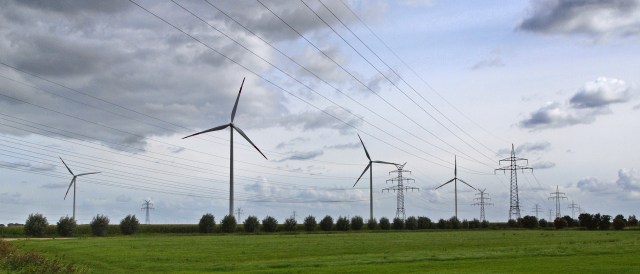In his last installment on Germany’s Network Agency’s Monitoring Report, Craig Morris looks for indications that renewable electricity is wreaking havoc on the grid.

Curtailment of renewable electricity is only a minor phenomenon in Germany – at least for now. (Photo by Kurrat, CC BY-NC-SA 2.0)
As we saw in my first post (link) of this series, the Network Agency attributes the main overload on the grid in 2012 to the failure of four conventional plants, not to the growth of renewables. Indeed, even in the short English version of the report (PDF), we find the following conclusion:
“The idea that the increase in decentralized power generation had a significant effect on the quality of energy supply can be ruled out for 2012.”
In the German full report, a similar sentence is more interesting and comes just after this graphic showing the minutes of downtime as defined in SAIDI (System Average Interruption Duration Index) – the value used for a comparison in one of our most popular charts.
At the bottom (dark green), we see the number of minutes of downtime at the medium-voltage level, with the low-voltage level – where households are connected – on top in the orange area. Most of those power outages, the report says, are the result of “third parties,” defined as “people, animals, trees, construction sites, vehicles, and flying objects.” And then comes another clear statement:
“A significant impact of the energy transition and the related increase in distributed generation capacity on supply quality can thus be ruled out for the year under review.”
There has been some concern about how much renewable electricity in Germany has to be curtailed (essentially meaning it is produced, but the grid cannot take it up), but the Monitoring Report 2013 shows that there was an improvement in 2012, with 0.33 percent of the total of renewable electricity having been curtailed, compared to 0.41 percent in 2011. Things got better, not worse.
Most of the renewable electricity curtailed (94 percent) is wind power, with solar only accounting for four percent. Here, we see the simultaneity of peak solar power production and peak power demand; more solar power is easier to take up because demand is usually higher around the early afternoon, when most solar power is produced. But wind can come around the clock.
Finally, it is hard to compare Germany’s performance to what’s happening in other countries for a lack of data elsewhere (but if you know of any sources, do drop us a link in the comments below).
Although curtailed renewable power is probably not a big deal yet, it is nonetheless good to remain focused on it. It is a good indicator of overall system efficiency and cost – at a time when policymakers focus too little on macroeconomics and too much on microeconomics. Wind farms concentrated in areas with the best resources may provide a cheaper kilowatt-hour only to entail additional grid costs further down the supply chain.
Craig Morris (@PPchef) is the lead author of German Energy Transition. He directs Petite Planète and writes every workday for Renewables International.
The UK National Grid Winter Outlook 2013/2014 (http://www.nationalgridmedia.com/winteroutlookreport.aspx)
gives figures on page 52 for wind curtailment. The most significant cause is the lack of grid capacity between north west Scotland and the rest of the UK. A major new transmission line will eventually (probably 2016) reduce curtailment from this cause.
NW Scotland may have the lowest LCOE in Europe for wind. Craig’s comment in the last paragraph applies.
Curtailment for reasons of grid stability is reasonably rare in the UK (and seems to be falling). As far as I know, no issues in the last few weeks of extremely high winds.
Chris Goodall
Thanks, Chris!
hi chris,
I want to know about the reactive power control & active power limitation at various curtailment in terms of high generation, in low P.F etc.